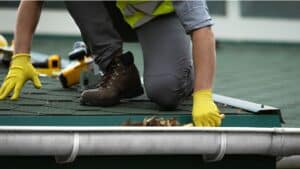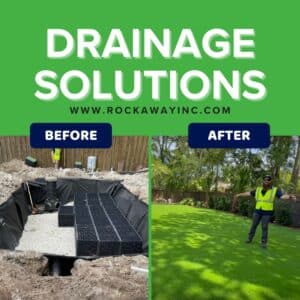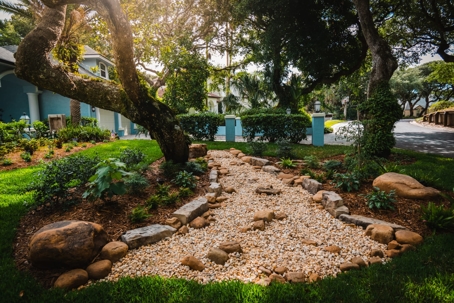There are several residential drainage system options. Here are six commonly used methods:
1. Surface Drainage: This involves creating slopes and channels on the ground to direct water away from your property. It can include using swales, French drains, or grading the land to ensure proper water flow. “Surface drainage is accomplished by land forming, grading, or smoothing to remove small depressions where water collects and to provide a uniform slope for the removal of surface water,” according to Agricultural Sustainability. “The orientation of the graded land and thus direction of surface drainage is normally toward an adjacent open drain (ditch).”

2. Gutter Systems: Installing and upgrading gutters and downspouts around your home’s roof can collect rainwater and direct it away from the foundation. Whatever gutter system you have, ensure that the gutters are in good condition and regularly cleared of debris to prevent clogging. Also, consider our article Common Drainage Problems.
3. Foundation Drainage: This method is designed to move water away from your home’s foundation. It typically involves installing a system of perforated pipes or drains, known as a perimeter drain, at the base of the foundation walls. “A residential foundation drainage system (or footing drain) generally consists of a perforated 4-inch plastic, PVC or flexible ABS pipe installed underground around the perimeter of your home to keep water out,” according to New Home Source. “First, a trench is dug, then the concrete footing and the concrete foundation wall are poured and cured. Next, the exterior is coated to prevent moisture intrusion. Water-proofing the exterior — not just damp-proofing — is highly recommended. Finally, the drainage pipe is installed with drain holes facing down. The pipe is run to daylight, a drywell, or a sump.”
4. Dry Wells: Dry wells are underground structures that collect and store excess water. They are typically used when the natural soil drainage is poor. Dry wells can be connected to downspouts or surface drains and are designed to release the collected water into the surrounding soil slowly. They have reinforced sides and are covered at the surface but permeable on the bottom, lined with rock or gravel.

5. Catch Basins: Similar to a dry well a catch basin is an underground structure that collects stormwater. Connect your downspouts and other surface drainage systems to your catch basin. One catch basin technology Rockaway uses that meet area stormwater permitting requirements involves framing the hole with Aquascape Aquablox enveloped in a thick rubber liner and covered at the surface with various products, including natural or synthetic turf or gravel. Pondless water features can also be integrated to add beauty and functionality to your otherwise hidden catch basin.
6. Rain Gardens and Dry Creek Beds: A rain garden is a landscaped area that is designed to capture and absorb rainwater runoff. These areas are terrific for native plantings and marginals that can acclimate to wet and dry places. Your choice of decorative rocks and gravel will help to filter the water and allow it to infiltrate slowly into the ground.
7. Retaining Walls: Retaining walls can help manage soil erosion and route water according to your plans for your property’s structures and landscape. By creating a barrier, retaining walls can prevent water from seeping into unwanted areas or pooling around your home. Wall block and paver retaining walls likewise add beauty and visual accents to driveways, around trees, patios, outdoor kitchens, and pool houses.
It’s essential to consider factors such as topography, soil type, and the severity of your drainage issues when deciding between the best drainage system options. Please book a consultation with one of our landscape architects, designers, and drainage specialists to help you determine the most effective solution for your situation.
From our office in Atlantic Beach and satellites throughout Northeast Florida, Rockaway Inc proudly serves both commercial and residential landscape design, maintenance, lawn care, irrigation, and outdoor living carpentry client needs in Jacksonville, St Augustine, Atlantic Beach, Neptune Beach, Jacksonville Beach, Ponte Vedra, Nocatee, St. Johns, and Fernandina Beach.

